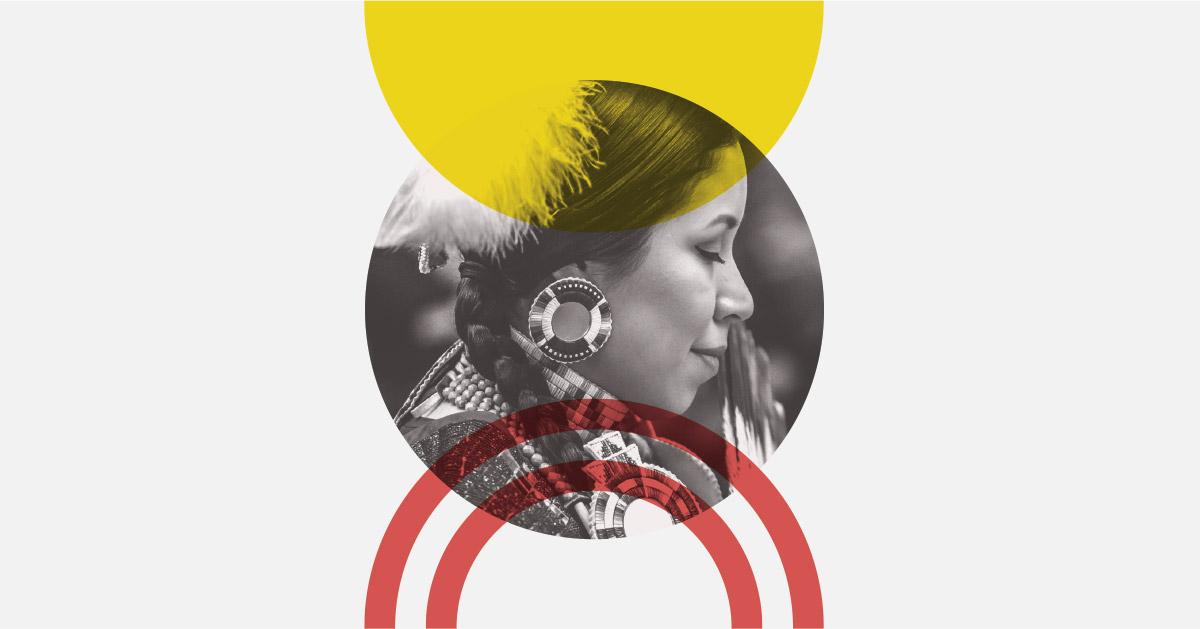Indigenous postsecondary education in Canada is a dynamic landscape marked by resilience, progress, and ongoing challenges. The latest data from Statistics Canada (StatsCan), as well as the 2021 census data, sheds light on this landscape, emphasizing the pivotal role of colleges and institutes and the need for ongoing efforts to ensure equitable access for these students.
Let’s take a look!
Indigenous Post-Secondary Education Trends
Despite facing challenges, Indigenous Peoples have made notable strides in education. While 16% of Indigenous peoples hold a university degree (compared to 36% of the overall population), 23% have obtained a college credential, and 11% have completed apprenticeships—figures that surpass those of the general population (Statistics Canada, 2021). Nevertheless, while the share of Indigenous adults with a bachelor’s degree or higher has increased since 2016, the gap between Indigenous and non-Indigenous populations has widened.
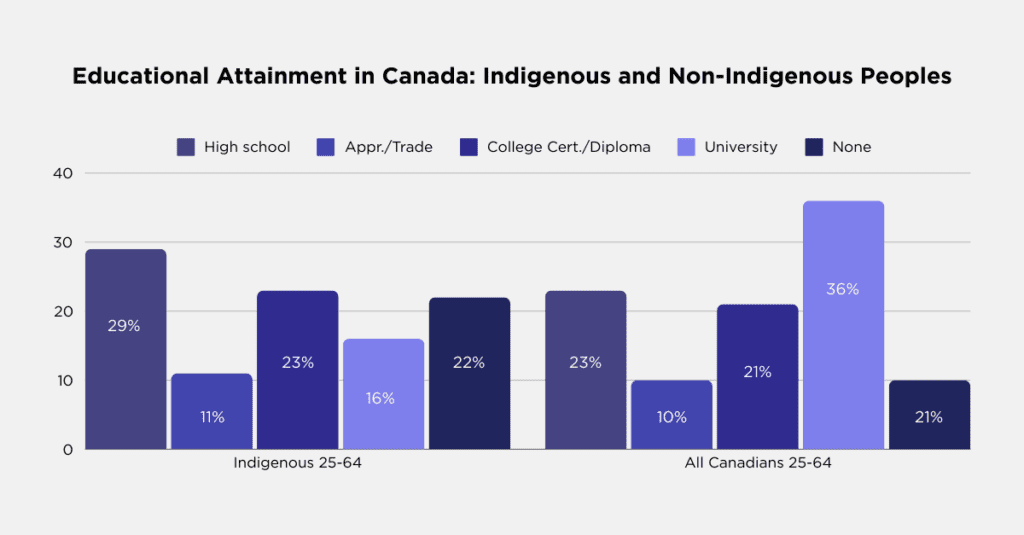
Did you know? Half of Indigenous new postsecondary entrants start their journey at colleges, compared to 37% of non-Indigenous entrants (Statistic Canada, 2024). Additionally, Indigenous new entrants at colleges are far more likely to be women and more likely to be 20 years or older compared to non-Indigenous new entrants. These statistics underscore the critical role colleges play in providing accessible and supportive educational opportunities – including delivery in community and essential wrap-around services – for Indigenous learners at any stage in their lives, regardless of their life circumstances.
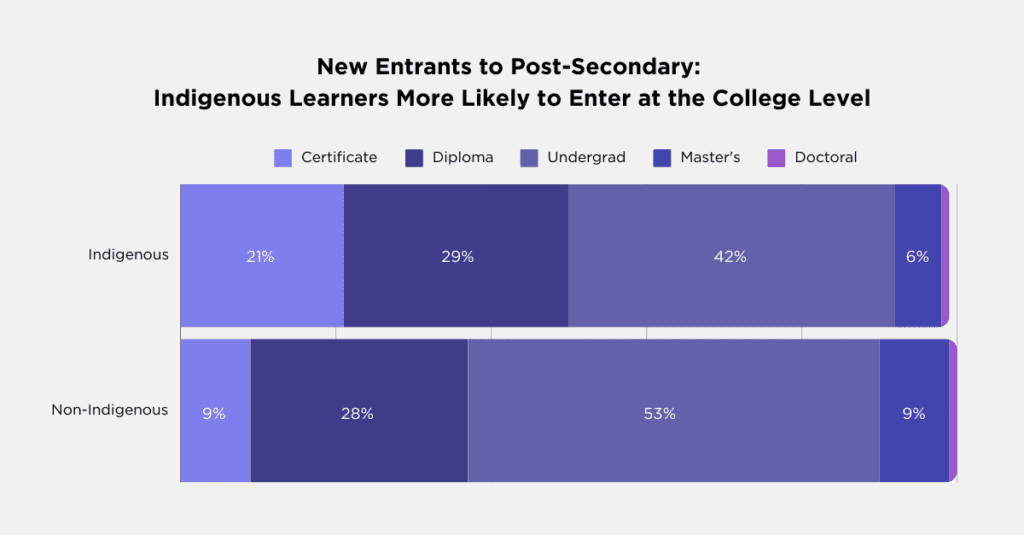
Navigating Challenges: Regional Disparities and Remote Living
The educational journey for Indigenous peoples isn’t without its challenges. Historical and ongoing injustices, such as the legacy of residential schools and intergenerational trauma, coupled with ongoing structural challenges like limited access to educational institutions, food insecurity and lack of childcare options while in school, have long cast a shadow over Indigenous education.
Among Indigenous populations, First Nations youth, in particular, face numerous challenges. These include higher rates of young parenthood, low-income households, and rural residence, contributing to a disparity in postsecondary completion rates compared to non-Indigenous youth. As a result of these challenges, non-Indigenous youth are nearly twice as likely (72%) to have completed or recently attended a postsecondary program as First Nations youth (37%) (Statistics Canada, 2023).
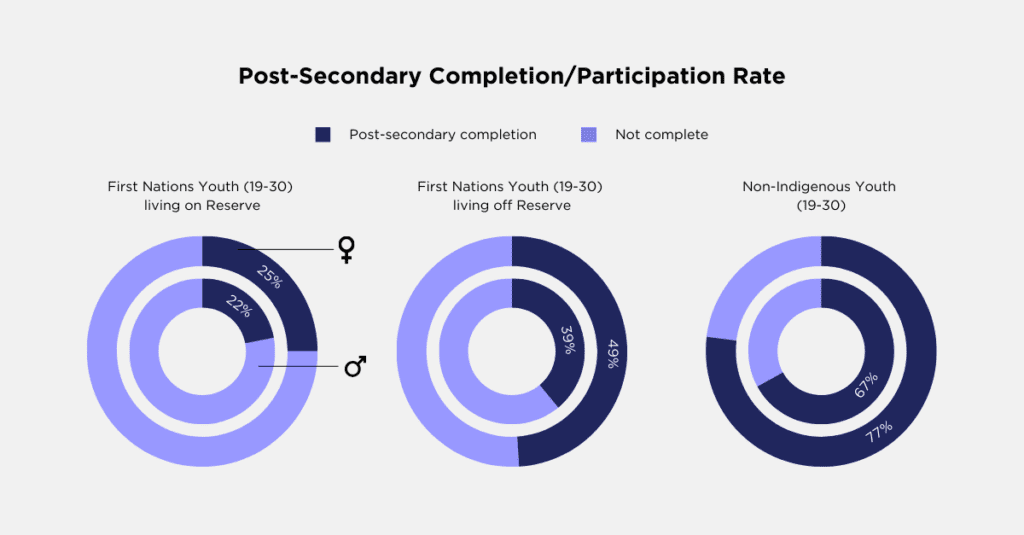
Adding to the complexity, Indigenous communities are disproportionately situated in rural and remote areas. In 2016, 26% of Indigenous individuals aged 19 to 45 lived in these regions, in stark contrast to just 3% of the non-Indigenous population (Statistics Canada, 2023).
How does this translate into educational outcomes? Those who lived in easily accessible areas completed high school in much higher proportions than those in very remote areas. An expanded age analysis also reveals that there are higher rates of high school completion and postsecondary education attendance among First Nations individuals living outside rural areas, with almost half of females and over a third of males attending or completing postsecondary education.
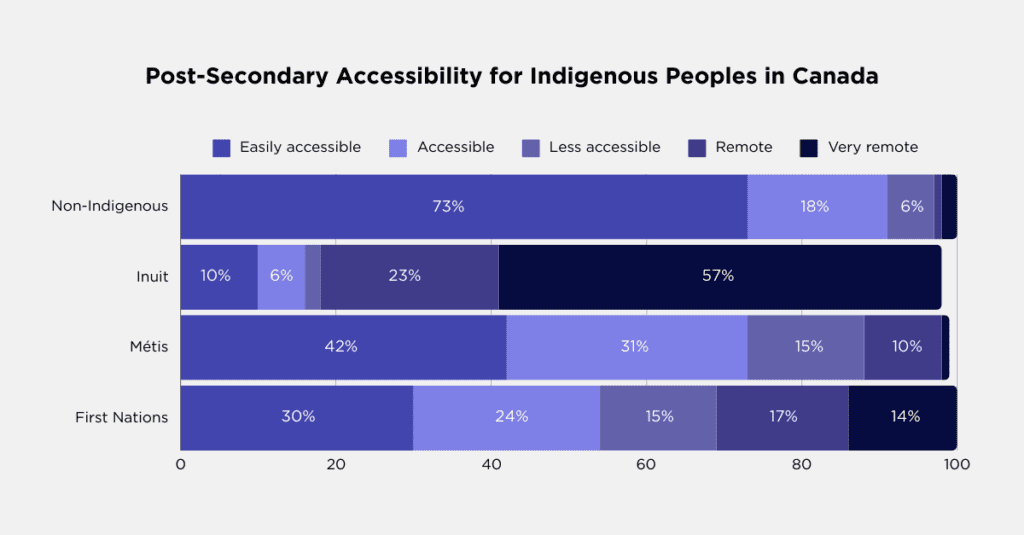
Proximity to postsecondary institutions, therefore, plays a crucial role in the success of Indigenous learners. Fortunately, 86% of Indigenous Peoples live within 50km of a college campus or service centre. However, proximity alone is not enough. Offering flexible, adaptable, and culturally responsive options—such as outreach programs, community partnerships, and online resources—is essential to bridging the gap in postsecondary education and empowering Indigenous learners to achieve their full potential.
Indigenous-led institutes across the country, such as those in Ontario, Saskatchewan, Alberta and British Columbia along with Northern colleges like Nunavut Arctic College and Yukon University, also play a unique leadership role. Their locations, combined with their capacity and cultural understanding, enable them to address community-driven needs and deliver programs that are relevant, accessible, and empowering for Indigenous learners.
Looking Ahead: Empowering Indigenous Youth for a Stronger Future
The Public Policy Forum reports that by 2026, around 350,000 Indigenous youth will reach adulthood. Empowering these individuals with high-quality, culturally relevant postsecondary education and training will not only promote social inclusion and justice but also help Canada address its underemployment and skill gaps. It is estimated that supporting these young people can boost our economy by a significant $27.7 billion each year (Public Policy Forum, 2024).
With their unique insights, Indigenous knowledge systems offer valuable solutions for addressing Canada’s pressing issues. More and more colleges are recognizing this and engaging in applied research community partnerships with Indigenous organizations as part of their commitment to social innovation and partner-driven research. At SAIT’s Centre for Innovation and Research in Unmanned Systems, for example, researchers are working with the Stoney Nakoda First Nations and Alberta Health Services to develop a scalable drone fleet that can support medical delivery and amplify drone signals in remote areas.
Indigenous-Focused Programs & Support
As the primary postsecondary education providers for Indigenous learners from across Canada, colleges and institutes continually strive to listen, learn, and collaborate with Indigenous Peoples to enhance the educational experiences of Indigenous learners. We offer flexible learning formats and support services such as childcare, counselling, and mentorship, along with nearly 300 Indigenous-focused programs and courses across Canada’s ten provinces and territories.
Through CICan’s national programs, such as Skills Compass, colleges and institutes are also making a significant impact by supporting Indigenous and newcomer youth not currently in education, employment, or training. The accessible initiative helps Indigenous youth develop essential skills and become career-ready and equips members with a Skills Compass Curriculum Framework—a lasting resource to help institutes tailor their programs to the unique needs of Indigenous youth.
Colleges and institutes also foster connections for Indigenous learners globally through Global Skills Opportunity (GSO). This initiative enables Canadian post-secondary students to gain new global skills, enhancing their resilience, adaptability, and readiness for success. For instance, I’M SIENT (International Mobility Supporting Indigenous Entrepreneurs), funded under GSO at Sault College in Ontario, empowers Indigenous students by enhancing technical and analytical skills in collaboration with Indigenous entrepreneurs in Mexico’s Yucatan region.
Recognizing that Indigenous reconciliation is an ongoing journey, we remain committed to culturally responsive approaches. Through continued dedication, the potential for positive change and empowerment within Indigenous communities is immense.
Take Action:
Colleges and institutes can advance their commitment by joining the 72 institutions that have signed CICan’s Indigenous Education Protocol. This protocol – created in 2014 – highlights the need for tailored structures and approaches to meet the educational needs of Indigenous peoples, supporting their self-determination and the socio-economic development of their communities.
To mark its 10th year anniversary and reflect on progress and stubborn gaps, CICan will be initiating a refresh of the protocol – and how to mobilize greater take by our member institutions – at our upcoming Indigenous Education Symposium in Halifax from October 27-29 that we are hosting in partnership with the Indigenous Institutes Consortium (IIC).

